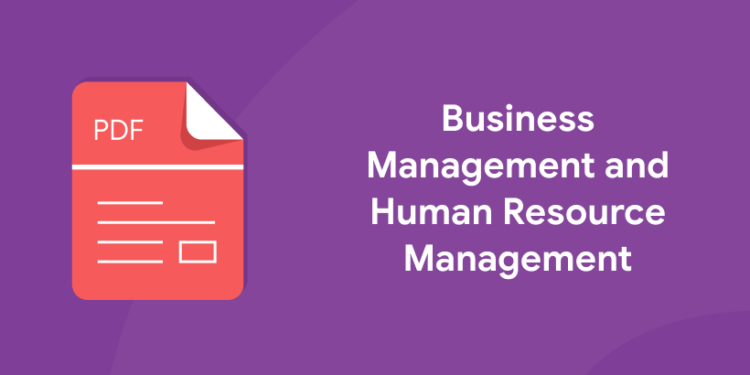Table of Contents
Business Management and Human Resource Management is the 6th unit in the syllabus of Commerce UGC NET 2022. The following article briefly describes the important portions and help with the preparation of Commerce UGC NET 2022 notes.
Management is the procedure of devising and sustaining an environment in which people, who are functioning together in units, proficiently achieve particular objectives.
General Principles of Management
Henri Fayol was one of the initial academics to put forward basic principles of management. He proposed a clear division between ‘General Principles of Management’ and ‘Elements of Management’. Fayol argues that these principles have universal application. They are valid in all types of organizations (business, government, military religion). They are essential or common facts and can be educated in schools and universities. Fayol also proposed that these principles were adaptable and are can be adapted to suit any kind of necessity. These philosophies are concisely stated below:
1)Division of Work: It includes distributing the labor between different departments and staff according to their aptitudes and proficiency. This thought aims to gain the advantage of specialization i.e. make more and improved products.
2) Authority and Responsibility: Authority should be relative to responsibility. When executives are bestowed authority, their responsibility must also be obvious.
3) Discipline: Discipline refers to conforming to and respecting the guidelines of the association. Fayol believed discipline was undeniably indispensable for the easy managing of the business. To maintain discipline there must be good managers at all stages, clear and fair contracts with staff and sensible usage of penalties.
4) Unity of Command: This idea expresses that every worker must take instructions from one Manager only. Multiple commands will lead to misunderstanding and disagreement.
5) Unity of Direction: This principle states that “there must be one head and one strategy” for a group of actions having a similar aim.
6) Subservience of Individual Interests to General Interest: The interest of one worker or group of workers should not come before the concern. Individual workers must not give importance to their interests. They must act in the interest of the association.
7) Remuneration: Workers must get fair payment for their assistance. Fair wages give fulfillment to both the staff and the company.
8) Centralization: This idea discusses the extent to which power should be centralized or decentralized in an association. The mark of centralization relies upon distinct situations. It must be done in such a way that the best results are obtained by the association.
9) Scalar Chain: The hierarchy of power from the highest levels of management to the lowest levels is referred to as the scalar chain. Commands and feedback trail this chain. It fashions a superior-subordinate relationship between the workers in the firm. For efficient administration, the scalar chain must be as short as possible.
10) Order: to make sure the easy flow of work and effective usage of physical and human resources, individuals and ingredients must be in the correct place at the correct time.
11) Equality: This idea argues that supervisors must provide equal, fair and kind treatment to their workers.
12) Stability of terms of employees: Instability is both the cause and effect of bad administration; the management must offer the stability of employment to its employees. This will produce a sense of security amongst the workers and decrease their work pressure.
13) Initiative: Administration should permit the workers to develop and use creativity for resolving work-related complications. This will aid workers to progress better in the association.
14) Espirit de Corps: By this idea “unity is strength”. Hence executives must try to build team spirit and harmony among the workers for accomplishing the administrative objectives
Human Resource Management (HRM)
HRM denotes the supervision of individuals in establishments. It includes the actions, rules, and practices concerned with procuring, developing, using, estimating, preserving, and retaining the sufficient amount and skill mix of workers to achieve the establishment’s aim. HRM aims to
maximize workers’ contributions to attain ideal efficiency and success, while simultaneously achieving individual aims (such as obtaining recognition in a challenging job), and societal aims (like legal obedience and demonstration of social responsibility).
Functions of human resource management
The functions can be grouped as follows:
- Strategic HR Management: for maintaining administrative competitiveness, tactical planning for HR efficiency can be amplified by utilizing HR metrics and HR technology. The human resource planning (HRP) function fix the amount and kind of workers required to achieve organizational objectives. HRP includes fashioning venture teams with a well-balanced skill mix, employing the correct people and voluntary team assignment.
- Equal Employment Opportunity: obeying equal employment opportunity (EEO) rules and regulations influences all other HR events.
- Staffing: The objective of staffing is to offer a good enough amount of competent people to fill jobs in an association. Job analysis, recruitment and selection are the key jobs that come under staffing.
- Talent Management and Development: It starts with the orientation of new workers, and comprises various kinds of training. Orientation is a technique to familiarize new workers with specific parts of their new job, involving pay and benefit programs, employed hours and organizational laws and prospects. Training and Development programs offer useful ways of guaranteeing that the workers are skilled in the execution of their tasks at satisfactory levels and more.
- Total Rewards: Recompense in the form of pay, incentives and benefits are the rewards offered to the workers for accomplishing organizational roles. Compensation supervision is the technique for deciding the amount workers should be rewarded for the execution of certain tasks. Compensation influences recruitment as individuals is usually fascinated with firms presenting an advanced level of salary in exchange for the task done. This function utilizes rewards to inspire workers to accomplish an establishment’s aims of productivity, creativity and profitability. Benefits are another kind of reward to workers other than the salary directly paid for the task completed. Benefits comprise both lawful obligatory matters and those provided at the owner’s pleasure.
- Risk Management and Worker Protection: HRM discusses different workplace hazards to guarantee the safety of employees by meeting legal necessities and being more receptive to worries for workplace health and protection along with disaster and recovery preparation.
- Employee and Labor Relations: The connection between supervisors and their workers must be treated legally and efficiently. It is imperative to advance, communicate, and update HR guidelines and measures so that administrators and staffs both know what is to be expected. The word labor relation points to the relation with workers who are represented by a trade union. Unions are an association of personnel who join together to get more voice in choices influencing wages, benefits, working situations and other facets of service. In labor relations, the main purpose of HR staff comprises negotiating with the unions concerning all the above-said matters.
The above article provides a general idea about the contents of units belonging to the topic of Business Management and Human Resource Management for commerce UGC NET 2022 paper 2. Collect notes and listen to video lectures on all the subtopics to score good marks. Download the Entri app to learn more topics coming under the unit of business management and human resource management for the commerce UGC NET 2022 exam.











